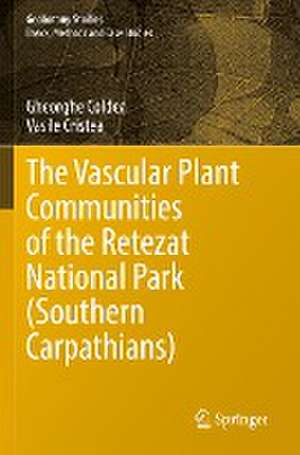The Vascular Plant Communities of the Retezat National Park (Southern Carpathians): Geobotany Studies
Autor Gheorghe Coldea, Vasile Cristeaen Limba Engleză Paperback – 29 sep 2023
| Toate formatele și edițiile | Preț | Express |
|---|---|---|
| Paperback (1) | 550.78 lei 38-44 zile | |
| Springer International Publishing – 29 sep 2023 | 550.78 lei 38-44 zile | |
| Hardback (1) | 646.62 lei 22-36 zile | |
| Springer International Publishing – 28 sep 2022 | 646.62 lei 22-36 zile |
Din seria Geobotany Studies
- 15%
 Preț: 643.00 lei
Preț: 643.00 lei - 20%
 Preț: 566.76 lei
Preț: 566.76 lei - 15%
 Preț: 636.80 lei
Preț: 636.80 lei - 15%
 Preț: 704.04 lei
Preț: 704.04 lei - 15%
 Preț: 638.24 lei
Preț: 638.24 lei - 15%
 Preț: 651.51 lei
Preț: 651.51 lei - 15%
 Preț: 649.06 lei
Preț: 649.06 lei - 20%
 Preț: 589.56 lei
Preț: 589.56 lei - 18%
 Preț: 961.10 lei
Preț: 961.10 lei - 15%
 Preț: 644.95 lei
Preț: 644.95 lei - 15%
 Preț: 662.80 lei
Preț: 662.80 lei - 15%
 Preț: 640.24 lei
Preț: 640.24 lei - 18%
 Preț: 945.30 lei
Preț: 945.30 lei - 18%
 Preț: 948.61 lei
Preț: 948.61 lei - 18%
 Preț: 1009.22 lei
Preț: 1009.22 lei - 18%
 Preț: 890.37 lei
Preț: 890.37 lei - 24%
 Preț: 784.06 lei
Preț: 784.06 lei - 19%
 Preț: 459.24 lei
Preț: 459.24 lei - 18%
 Preț: 1115.77 lei
Preț: 1115.77 lei - 18%
 Preț: 1115.46 lei
Preț: 1115.46 lei
Preț: 550.78 lei
Preț vechi: 679.97 lei
-19% Nou
Puncte Express: 826
Preț estimativ în valută:
105.39€ • 110.32$ • 87.72£
105.39€ • 110.32$ • 87.72£
Carte tipărită la comandă
Livrare economică 26 martie-01 aprilie
Preluare comenzi: 021 569.72.76
Specificații
ISBN-13: 9783031056208
ISBN-10: 3031056205
Pagini: 259
Ilustrații: XI, 259 p. 77 illus., 76 illus. in color.
Dimensiuni: 155 x 235 mm
Ediția:1st ed. 2022
Editura: Springer International Publishing
Colecția Springer
Seria Geobotany Studies
Locul publicării:Cham, Switzerland
ISBN-10: 3031056205
Pagini: 259
Ilustrații: XI, 259 p. 77 illus., 76 illus. in color.
Dimensiuni: 155 x 235 mm
Ediția:1st ed. 2022
Editura: Springer International Publishing
Colecția Springer
Seria Geobotany Studies
Locul publicării:Cham, Switzerland
Cuprins
1. Physical, Geographical and Geological Description of the Retezat Mountains.- 2. History of Floristic and Vegetation Research.- 3. Areal-Geographical Characterization of the Retezat Flora and the Endangered Species.- 4. Mapping Rare, Endangered Angiosperm Species of Phytogeographical Interest from the Retezat National Park.- 5. Vegetation of the Retezat Mountains.- 6. Description of the Plant Associations Distinguished in the Retezat National Park.- 7. Considerations on the Flora, Vegetation and Conservation of the Plant Gene Pool in the Retezat National Park.
Textul de pe ultima copertă
The floristic studies carried out during the 19th and 20th centuries in the Retezat Massif identified 1,152 plant species and 104 subspecies within the Cormobionta sub-regnum. Of these, about 12% are endemic Carpathian and Dacian-Balkan taxa that induce a regional specificity to the hosting communities. The phytocoenological research led to the description of 67 plant associations, grouped in 28 alliances, 19 orders and 13 vegetation classes. These classes are: Asplenietea trichomanis, Thlaspietea rotundifolii, Salicetea herbaceae, Montio-Cardaminetea, Scheuchzerio-Caricetea fuscae, Oxycocco-Sphagnetea, Molinio-Arrhenatheretea, Caricetea curvulae, Loisleurio-Vaccinietea, Elyno-Seslerietea, Mulgedio-Aconitetea, Carpino-Fagetea and Vaccinio-Piceetea. The following plant associations herein described are new syntaxa: Phyteumo confusi-Junicetum trifidi, Salici kitaibelianae-Dryadetum octopetalae and Aconito taurici-Rumicetum alpine. For the protection of some rare plant species and vulnerable plant associations, two natural reserves are proposed to be created within the “Limestone Retezat” area.
Caracteristici
Three newly described syntaxa and updated vegetation classification in the Retezat Mountains Sixty-seven floristic tables, each table referring to a different syntaxon Sixty maps showing the distribution of rare and endangered species in the Retezat Mountains
